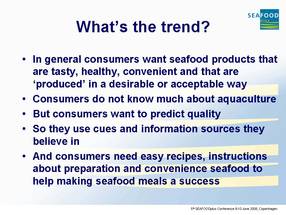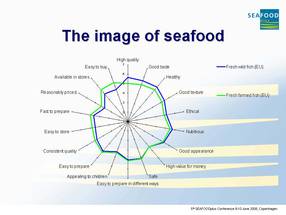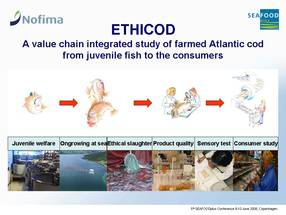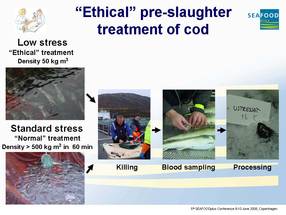|
|
|
For the Fifth Open SEAFOODplus Conference in Copenhagen 8-10 June 2008 a Book of Abstract will be distributed to the participants. The book contains abstracts of all presentations given at the conference, all abstracts of the posters presented, a list of participants, and a welcome address by the SEAFOODplus secretariat and the Coordinator. Further, a CD ROM comes with the book containing pdf files of all presentations given at the conference. Below are given two examples of abstracts, selected on the basis of one presentation to be given on Monday 9 June, and one presentation given Tuesday 10 June. Also a pdf file of each abstract page as it it will appear in the Book of Abstracts can be downloaded for free.
If you have not registered for attending the conference and getting your own copy of the full conference material, please do so urgently, as 30 May will be the final day for registration.
Presenting author: Karen Brunsø (1) co-authors: Joachim Scholderer, Karina
Birch Hansen (1), Svein Ottar Olsen (2),Wim Verbeke (3)
(1)MAPP, Aarhus School of Business, University of Aarhus, Denmark
(2) Nofima and the Norwegian College of Fishery Science, University of Tromsø
(3) Department of Agricultural Economics, Ghent University, Belgium

The aim of the project CONSUMERSURVEY is to investigate eating habits, attitudes and preferences towards fish and seafood as well as trace trends over time across Europe.
Consumers choose seafood products based on how they believe the product may contribute to the achievement of desired consequences and values, e.g. a nice and enjoyable family meal or a feeling of being a good cook. Information such as a label and its information about safety, traceability or sustainability may, for example, generate expectations about high eating quality – giving the consumer a feeling of luxury – or expectations about improved health, and of pleasure in life.
So far, our consumer studies have indicated that consumers hold various beliefs and perceptions about seafood and farmed and wild fish. These are not necessarily based on objective de-facto knowledge. While fish and seafood in general are perceived as healthy, nutritious and safe food products, there seems to be more confusion when the subject of wild and farmed fish is raised and findings indicate that consumer awareness and knowledge about the farmed or wild origin of the fish they buy is rather vague. As production methods gain importance to many consumers, issues of ethical production, animal treatment and welfare, organic and environment-friendly production systems as well as sustainability seem to gain more influence on seafood product choices. When consumers try to judge whether a seafood product is healthy or a production method is natural or sustainable, they base their evaluation on available quality cues they understand – colour, safety guaranties, information about origin, expert advice.
 - Click on slide to enlarge
Furthermore, beyond the factors mentioned above which influence the evaluation of seafood quality, the aspect of being able to actually prepare a meal with fish is an important concern for many consumers. Many consumers experience problems and have a desire for more convenient seafood products. Still, consumers differ, some are not very interested in seafood, others are interested, but in very different ways. Such differences lead to different patterns of preference formation and food choice, and grouping of consumers into segments is an improvement over undifferentiated approaches to ‘the consumer.’ Our recent segmentation study has revealed four segments with quite different convenience orientations: (1) The Convenience segment, (2) The Critical segment, (3) The Independence segment and (4) The Traditional segment.
Finally, new results have revealed changes in some priorities over time, while others have remained the same and have also shed new light over the aspect of seafood supplements like the perception and use of Omega 3 fatty acid supplements, and into how consumers perceive seafood in contrast with other types of meat, e.g. meat, pork and poultry.
Download full abstract as pdf file
Presenting author: Børge Damsgård, co-authors: Hilde Toften, Øyvind
Aas-Hansen, Kjell Midling
Nofima Marine, Norway
 - Click on slide to enlarge
The main objective of the project ETHIQUAL is to examine how husbandry practices, aquaculture systems and pre-slaughter conditions contribute to the flesh quality and ethical quality of finfish seafood.
This objective in ETHIQUAL has been met with a range of studies, including different farm species and scientific question. In addition, the ETHICOD approach aimed to integrate many of these issues into a full value chain approach in one fish species. The approach covered the biological mechanisms (RTD pillar 5), the fish quality aspects (RTD pillar 4) and the consumer perspective (RTD pillar 2). This full scale value chain experiment tracked individual tagged Atlantic cod (Gadus morhua) from juveniles to slaughter, and to the consumer.
In general, the relationships between ‘ethical’ husbandry and muscle quality are complex, and the consumer perception may be affected of both flesh quality and perceived quality traits, based upon the product information. A combined study of biological mechanisms and public perception may thus contribute to understand the relative importance of ethical traits in farmed fish.
 - Click on slide to enlarge
In the biological part of ETHICOD, the first part focuses on water quality and fish density in juvenile cod production. The study revealed a poorer welfare in intensive reared groups with high densities which were not compensated with higher water flow. The reduction in welfare status led to nephrocalcinosis and 20-30% growth reduction.
The second part during the on-grow period in sea cages terminated after 1.5 years at an average fish size of 1.5 kg. The sub-optimal rearing in juveniles was not compensated and the optimal reared juveniles were 10% larger at slaughter than the more intensive groups, revealing long term effects of poor welfare status in juvenile fish.
A standard pre-slaughter protocol were compared with a more ‘ethical’ protocol. Compared to e.g. salmonids, the Atlantic cod were less affected by pre-slaughter treatment, and changes in e.g. plasma cortisol and lactate indicated that welfare was little affected. After slaughter, the fish was processed in a fish industrial plant, and the filets were distributed to a flesh quality study, a sensory study in a trained panel, and to an in-home consumer survey.
Download full abstract as pdf file
|
|
|
|